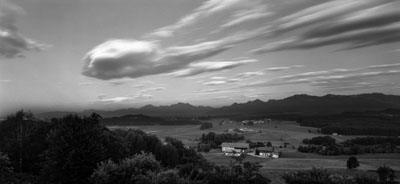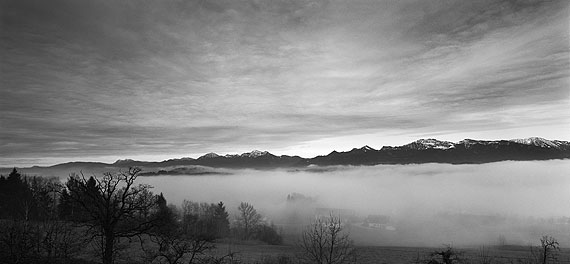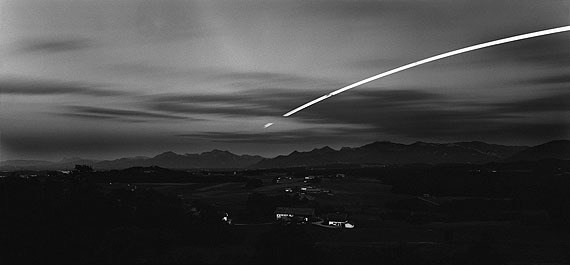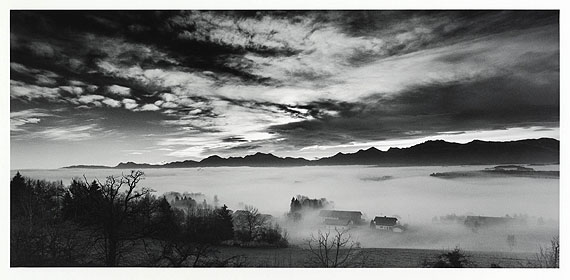
Michael Ruetz »
Sichtbare Zeit II - Eye on Infinity II
Exhibition: 10 Apr – 19 Jun 2011
Kunstraum Potsdam
Schiffbauergasse 4d
14467 Potsdam
+49 (0)331-730 416 52
info@kunstraumpotsdam.de
www.kunstraumpotsdam.de
Wed-Sun 12-18

Michael Ruetz - Eye on Infinity II
Photographs are repositories of time – but in a paradoxical sense, since the time they preserve or show remains unspecified. A millisecond exposure depicts the same surface, perspective and spatial situation as an image with an exposure time of fourteen hours. This, precisely, is the theme of Michael Ruetz’ "Eye on Infinity" project, portraying the effect of time in shaping images which themselves have a different temporal existence. The technical means employed may suggest a form of Romantic landscape photography, but in fact, – as in the work of many Romantic artists of the early nineteenth century, before and during the invention of photography – the conception of the project has a rigorous, scientific logic. It relies, however, on models from painting and literature, instead of taking its lead from the early history of photography. A line can be drawn here from Goethe's aesthetic of sensibility to the palette of Philipp Otto Runge – artists who could know nothing of photography but contributed more to the medium than many inventors of instruments and techniques. Tracing the contours of these models in his major serial work, Michael Ruetz at the same time investigates the artistic foundations of photography.
The experimental set-up – described in concise scientific terms by its title, EYE ON INFINITY / THE PERENNIAL EYE / TIMESCAPE 817.0 – 817.∞ – has the simplicity of all epistemology: the same vantage point, nearly always the same lens and monochrome film, the same gaze, over a period of more than 25 years. The result is a classic product of what art historians call "artists' theory", as exemplified by Constable's cloud studies at Hampstead – the cloud No. 9 is surely a particular favourite – or Monet's Rouen Cathedral series, exploring the effects of light, but also by more modern works such as Dan Flavin's structures of neon tubes or John Latham's "Time Base Roller". The series is not concerned with meteorology or cosmology or the physical limits of analogue photography; its purpose, rather, is a long-term observation of artist and work, with a substantial residue of formal quality that largely evades the linguistic definition required by science. Thus the scope for addressing the work through language, especially by hermeneutic exercises such as iconography or close reading, is strictly limited.
The subject-matter of the individual images appears at first to be of lesser significance. The landscape that opens up in front of the viewer is, admittedly, breathtaking, and comparisons between multiple images reveal the architectural changes that have taken place over years and decades. The exposure time can be inferred, in some cases, from the trajectory of the moon or the traces of car headlights; the fireworks in a number of photographs show that they were taken on New Year's Eve. But who cares about such details, which for this series of images have no material importance? The path of the sunlight, the mists and horizons, the cloud formations and hilltops, are more informative, speaking of the different ways in which nature can be seen and rendered through a technique of depiction. And the shades of black, white and grey, abstracting from everyday appearance, hark back to the early experiences of photography with the making of images, and to the experience of Michael Ruetz himself, who has shown often enough, with cycles of colour photographs, that he is a master of this technique, too.
It takes time for the viewer to find a way into these pictures. Then, however, time becomes visible at several levels, including, eventually, the viewer's own time in exploring the image. Here, the “two-eyed picture” format is relevant to the experience of time: standing up close to the picture, the viewer loses sight of the edges and is absorbed into the image, from which there is no immediate escape. The larger the image, the greater the effect; to this end, inter alia, it was important for Ruetz to use the best possible technical equipment, and thereby maximise the scope for choice in displaying the photographs, according to the site and situation of the exhibition. Ultimately, the viewer should be as unafraid of the landscape as of Barnett Newman's "Red, Yellow and Blue". The reference to the time required for viewing the picture is not only a gesture of homage to an illustrious fellow-artist, but also a reflection of Ruetz' own past, as a professor at a university of fine arts renowned for the quality of its work in the areas of video and performance art – both media are genuine time-thieves, and Ruetz has incorporated something of this in his large-format timescapes.
Although the pictures in EYE ON INFINITY are numbered chronologically, the manner of their arrangement in exhibitions and books, and on websites, is largely open. Each new juxtaposition makes time visible in a new way, always as a difference between two or three images, seen simultaneously and synchronically; but also through nuances of size and lighting, allowing weather, time, light and space to condense into ever-new images. In principle, the series is never-ending; a point of completion would only be reached if Ruetz were to abandon the camera location.
One of the finest paintings by Louis Jacques Mandé Daguerre, the inventor of photography, bears the title "The Effect of Fog and Snow" – encapsulating what all photography is about. With EYE ON INFINITY Michael Ruetz has restored to photography one of its essential definitions as a medium. The visible content of photographic images can be taken as a perceptual offering: allusions to a past reality are accompanied – especially in the gaps between the known fragments of reality repeated throughout the cycle – by elements that resist quick and easy decipherment. The viewer with time to spare, and the readiness to engage actively with these elements of Ruetz’ photographs, will not only find a source of aesthetic pleasure but can also learn much about a medium whose relationship to time is still largely uncharted.
Rolf Sachsse
Michael Ruetz - Sichtbare Zeit II
Einladung zur Vernissage
am So, 10. April 2011 um 16 Uhr
Begrüßung: Katja Dietrich-Kröck
Künstlerische Leiterin des Kunstraums Potsdam
Einführung: Dr. Rolf Sachsse
Kurator der Ausstellung
Michael Ruetz zählt zu den renommiertesten Fotografen Deutschlands. Bekannt wurde er Ende der 60er Jahre durch seine Bilder der westdeutschen Studentenbewegung. In den 1960er und 1970er Jahren bereiste er im Auftrag des Stern die DDR, u.a. während der Weltfestspiele der Jugend 1973 und des 1. Mai 1974. Ebenso fotografierte Michael Ruetz die Akteure und Liquidatoren des Prager Frühlings. In weiteren Reportagen zeigte er Griechenland zur Zeit der Militärdiktatur, Chile nach dem Wahlsieg Salvador Allendes und Guinea-Bissau im Unabhängigkeitskrieg. Aus der Zeit um 1970 stammen Porträts von François Mitterrand, Helmut Kohl und anderen europäischen Politikern. Neuere Projekte setzen sich mit den Möglichkeiten der Visualisierung von Zeit bzw. Vergänglichkeit auseinander. Der zweite Blick, Timescape und Der unverwandte Blick dokumentieren den Wandel der "sichtbaren Umwelt" im Verlauf der Zeit. Unter dem Titel Eye on Time widmet sich Michael Ruetz in größeren Zeitabständen demselben Objekt und Thema und hält so Veränderungen und Entwicklungen desselben Ortes über Jahre fest.
Ausstellungsdauer: 10. April bis 19. Juni 2011
Öffnungszeiten: Mi bis So 12 - 18 Uhr
Kunstraum Potsdam
Schiffbauergasse 4d
Der Kunstraum ist eine Einrichtung der Waschhaus Potsdam gGmbH. Wir danken dem Fachbereich Kultur und Museum der Landeshauptstadt Potsdam und dem Ministerium für Wissenschaft, Forschung und Kultur des Landes Brandenburg.


